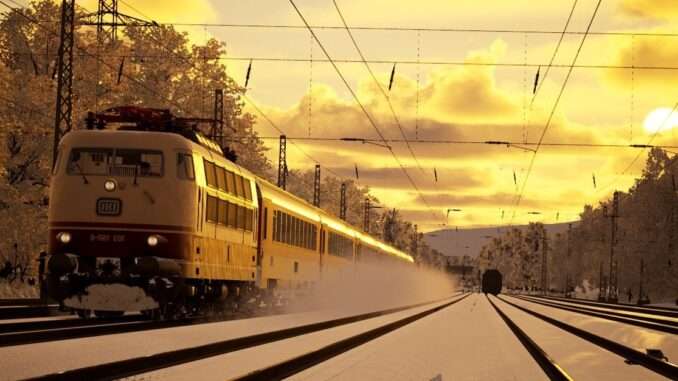
DB BR 363
Overview

Known long ago as the DB Class V 60, the BR 363 originated from the 1950s as a new standard small shunter design for use in yards, sidings and even on light freight and passenger work on branchlines across Germany. In the fleet’s production phase, many changes would be undertaken to alter their characteristics, including giving some stronger, heavier frames, increasing the shunter’s overall tractive effort for the hardest of freight-shifting tasks. Out of the 900+ locomotives built, 319 were the “heavy” variant.
Through various rounds of reclassification, its the BR 363 which today is part of the pool of heavy shunters, and despite their age, many remain in active service. Some have been sent to private railways and even to other countries, but they still see use in Germany, even still sporting the older DB blue livery.
- Manufacturer: Mak, Krupp, Henschel & Others
- Build Location: Multiple in Germany
- Build Date: 1956-1964
- Number Built: 942 locos (all V60s)
- Transmission: Hydraulic
- Prime Mover: Caterpillar 12-cylinder
- Power Output: 640 horsepower
- Length: 10.45 Metres (34 ft)
- Weight: 53 Metric Tons
- Top Speed: 60 km/h (37 mph)
DB BR 363 Cab – 1/2
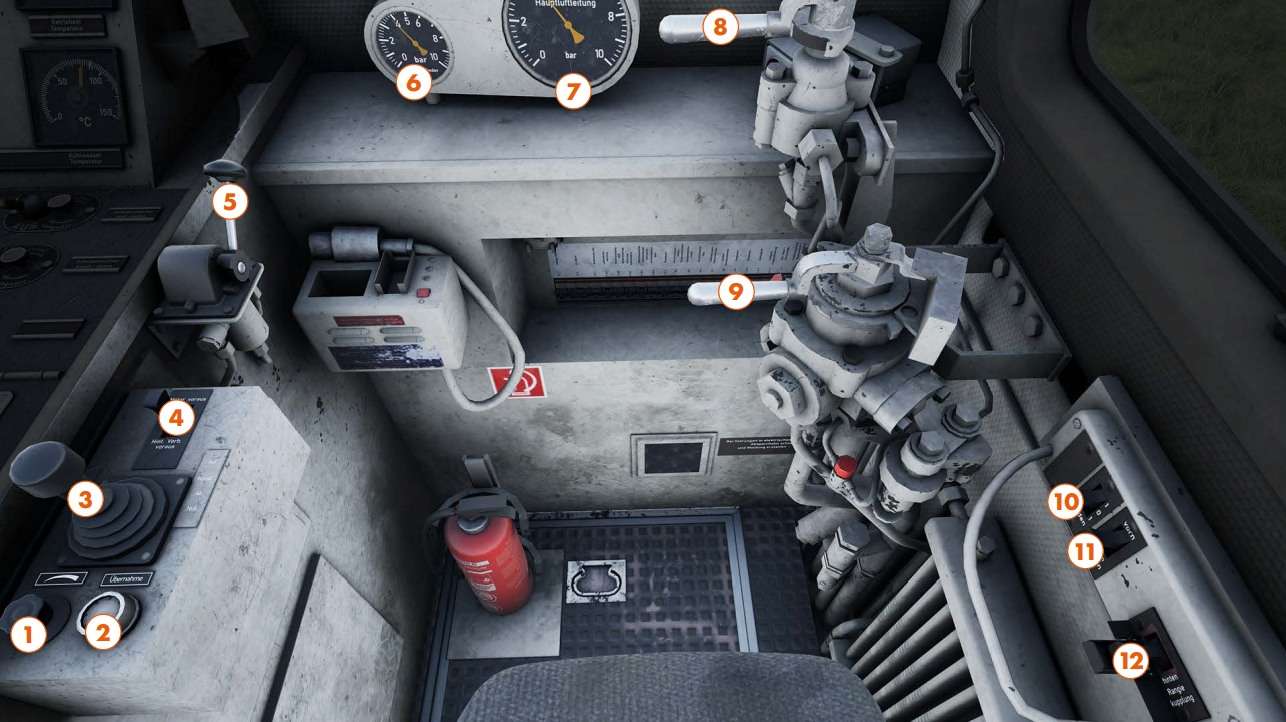
- 1 – Changeover Dimmer Switch
- 2 – Changeover Button
- 3 – Throttle Lever
- 4 – Reverser
- 5 – Fine Control Valve
- 6 – Brake Cylinder Gauge
- 7 – Brake Pipe Gauge
- 8 – Direct Brake Handle
- 9 – Train Brake Handle
- 10 – Sand Switch
- 11 – Horn Switch
- 12 – Uncouple Switch
DB BR 363 Cab – 2/2
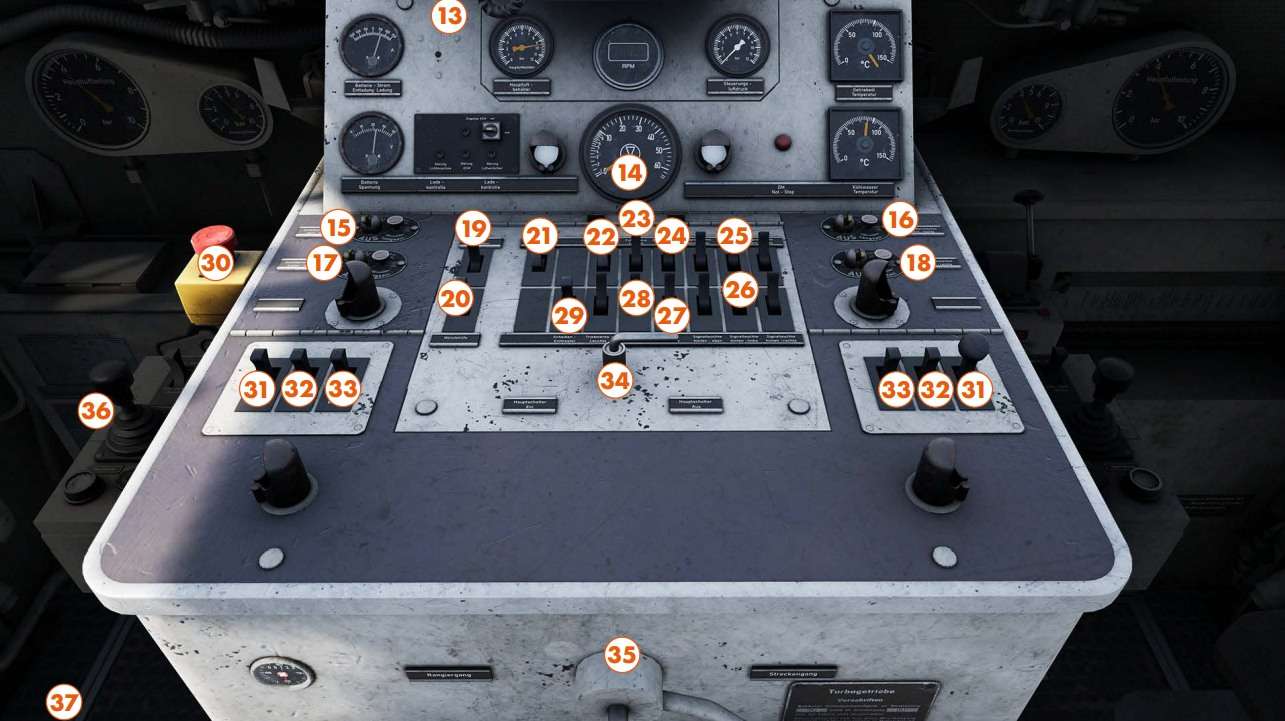
- 13 – PZB Breaker Cover & Switch
- 14 – Speedometer
- 15 – Front Left Wiper Controls
- 16 – Front Right Wiper Controls
- 17 – Rear Left Wiper Controls
- 18 – Rear Right Wiper Controls
- 19 – Engine Start Switch
- 20 – Engine Stop Switch
- 21 – Fuel Pump Switch
- 22 – Power Switch
- 23 – Cab Light Switch
- 24 – Engine Room Light Switch
- 25 – Front Headlight Switches
- 26 – Rear Headlight Switches
- 27 – Stem Lights Swtch
- 28 – Instrument Lights Switch
- 29 – Engine Light Switch
- 30 – Emergency Stop Plunger
- 31 – PZB Acknowledge
- 32 – PZB Release
- 33 – PZB Override
- 34 – Master Key
- 35 – Gear Selector Handle
- 36 – Mirrored Cab Controls
- 37 – (Right Cab Door) Handbrake Wheel
Procedures & Unique Features
Cab Changeover
- One unique feature of the BR 363 is its duplicated driving controls on each side of the cab, however, only one side can be actively controlling the train at any given time.
- Whichever side you sit down on, and after turning the master key, you must press the Changeover button to activate the controls on your side of the cab.
- If you get in and out the cab a lot and cannot recall which side was last used, the active side’s Changeover button should be illuminated.
Throttle Control
- Unlike most trains, where the throttle sets a certain percentage of power or even a desired speed, the throttle in the BR 363 acts like a sprung lapped brake control.
- There are multiple positions; Idle, Run Down, Hold and Increasing.
- You must hold the throttle in the Increasing position to gain RPM, once you have achieved the desired RPM, you move the throttle back into the Hold position, equally to reduce power, you hold the throttle in the Run Down position, or bring it all the way back to Idle.
Brake Control
- The BR 363 also features a lapped braking control, as having fine control over your speed in shunting circumstances is essential for safely buffering up to rolling stock.
- To operate these, you will need to move the Train Brake handle in the Service Apply position, then move it back into Lap once the desired brake force has been achieved.
- Unlike the throttle, and the PBL brakes found on the Class 66, the Train Brake in the 363 is not sprung, so you need to manually return it to the lapped position, otherwise a full application will take place.
Gear Selector
- The BR 363 has a gear selector on the central desk, this sets the locomotive up either for shunting or long distance use by altering the gear ratio of the hydraulic transmission.
- Long Distance will allow you to reach a top speed of 60 km/h, at the expense of some tractive effort.
- Shunting will trade speed for power, you will be limited to 30 km/h but be able to haul heavier trains.
- Naturally, the mode should be switched to Long Distance on the mainline, and in Shunting when assembling or disassembling trains in yards.
- The train must be stationary to switch between gear modes.
Overspeed protection
- To avoid overloading the gear transmission and cause damage to the locomotive, there is an automatic built-in overspeed protection, which catches the train if running faster than it should be.
- If you are in Long distance mode, the protection will kick in above 60 km/h.
- If you are in Shunting mode, the protection will kick in above 30 km/h.
- The protection cuts engine power and applies a full emergency brake application, and then automatically releases the brake once back and re-applies power once back under a safe speed – note this can be quite jarring when travelling as a light loco.



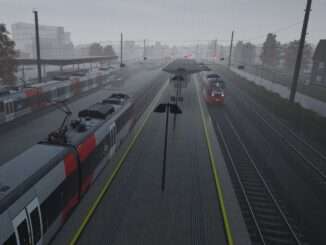
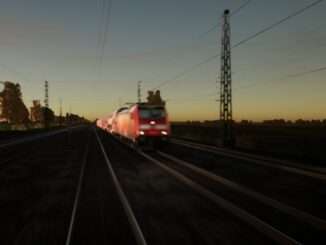
Be the first to comment